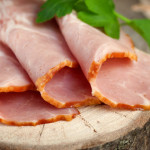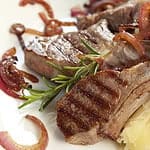Simnel cake is a traditional English fruitcake eaten during the Easter season and has been eaten since medieval times. The cake is both a rich, sweet treat and a symbolic ritual. The fruit cake is topped with eleven marzipan balls to represent the eleven apostles of Christ, minus Judas.
“Work With What You Got!”
©Tiny New York Kitchen © 2019 All Rights Reserved
Add this Cucumber Cabbage Salad to your Easter or Passover menu. Fresh dill adds bright spring flavor to this crunchy salad.
The orange carrot we know and love today came originally from Holland, but up until the Middle Ages, all carrots were purple. Gardeners often delight in such oddities, but you will be very lucky to find any purple specimens available in stores or supermarkets.
Carrots contain large amounts of carotene and vitamin A, along with useful amounts of vitamins B3, C and E. When eaten raw, they also provide potassium, calcium, iron and zinc, but these are partly destroyed with cooking.
Almost all vegetables have a better flavor if they are grown organically, but this is particularly true of carrots. If possible, buy organic ones, or look for the young, pencil-thin carrots that still have their feathery tops attached. These young carrots can be eaten raw, or steamed for a few minutes. Older carrots should be unblemished and feel firm. Carrots should not be stored for too long, but they will keep for several days in a cool airy place or in the salad drawer of the refrigerator.
The age of carrots is a guide to how they should be prepared. The valuable nutrients lies either in or just beneath the skin, so if the carrots are young, simply scrub them. Medium-size carrots may need to be scraped with a knife before cooking them and large carrots will need to be scraped or peeled. Carrots can be cooked or eaten raw. To eat raw, they can be cut into julienne strips and tossed with a dressing, or grated into salads and coleslaw. They can bee cooked in almost any way you choose. As an accompaniment, cut them into julienne strips and braise in butter and cider. Roasted carrots are delicious, with a melt-in-the-mouth sweetness. Par-boil large ones first, but younger carrots can be quickly blanched or added direct to the pan with a joint of meat.
“Work With What You Got!”
© Victoria Hart Glavin Tiny New York Kitchen © 2017 All Rights Reserved
Peeps!
Tiny New York Kitchen Wishes You & Your Family A Very Happy Easter!
The weather here in the Northeast has been unbelievably wonderful. It is so nice to have daffodils in my house as a confirmation that spring is around the corner.
I love the smell of these Easter Lilies in my sunroom.
Tiny New York Kitchen Wishes You And Your Family A Very Happy Easter!
Cooking Ham
Ham is a great choice for spring gatherings. It’s simple, feeds a crowd and provides wonderful leftovers.
Keep Servings In Mind. Allow for 1/2 to 3/4 pound per serving for bone-in ham, and 1/4 to 1/2 pound per serving for boneless ham.
Before Cooking make sure to let ham sit at room temperature for approximately 1 hour.
Scoring The Skin adds to a beautiful presentation. Cut 1/4 inch deep crosswise into 1 to 2 inch squares to create classic diamond shapes.
Glaze The Ham during the final hour of cooking to avoid burning.
Keep The Flavor Going. Buying bone-in ham leaves you with the ham bone, which is great for flavoring soups and beans.
“Work With What You Got!”
© Victoria Hart Glavin Tiny New York Kitchen
Cooking Lamb
Lamb is versatile and can be prepared quickly for a spur-of-the-moment gathering or roasted to perfection and served with a range of accompaniments.
Let The Cut Determine The Cooking Technique. For tender cuts like a rack, chops, loin, sirloin, or leg it’s best to broil, roast, grill, pan fry or sauté. For less tender cuts like shank or shoulder roast it’s best to braise or stew.
Store Lamb For 1-2 Days In The Refrigerator. Or you may freeze for up to 3 months. Thaw slowly in the refrigerator for a day or two before cooking.
Get Creative With Spice Rubs. Mix garlic, ginger, cardamom, cloves, chili pepper, and fenugreek for an Ethiopian style spice rub. Or create your own custom blend.
Always Test Doneness With A Meat Thermometer. Cook ground lamb to at least 160 degrees and other cuts to at least 145 degrees.
Make “Spring Burgers” With Ground Lamb. Season with dill, mint, or rosemary. Top with chopped fresh tomatoes and feta cheese.
“Work With What You Got!”
© Victoria Hart Glavin Tiny New York Kitchen















